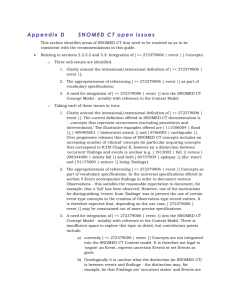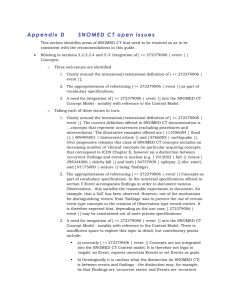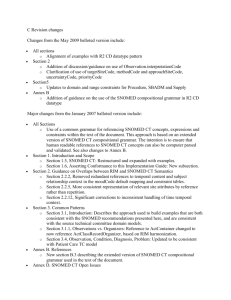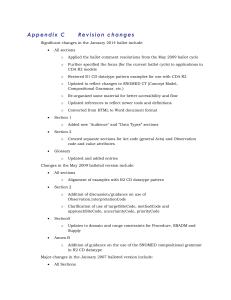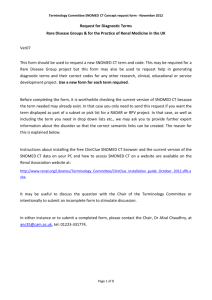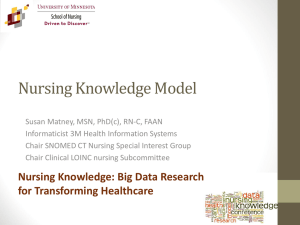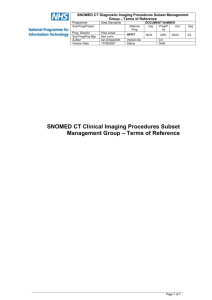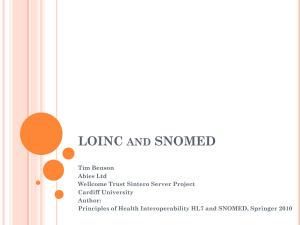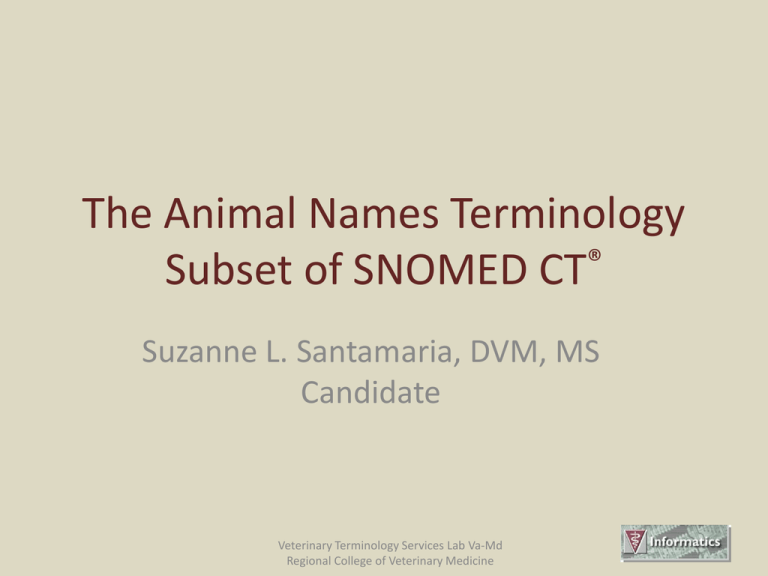
The Animal Names Terminology
Subset of SNOMED CT®
Suzanne L. Santamaria, DVM, MS
Candidate
Veterinary Terminology Services Lab Va-Md
Regional College of Veterinary Medicine
Identification
Integration
Importance
increases
Identification of animals is vital
• Animal name foundation of medical record
• Mixture of Linnaean and common:
– Linnaean terminology for scientific names
• Class Aves, Bos taurus
– Common animal names used by caretakers
• Bird, cattle, psittacine bird
• Ambiguity in animal names remains
– Cattle = Bos taurus? Cattle = Beefalo? Cow?
– Cattle = any animal of subfamily Bovinae that is commonly
domesticated, varies by country of origin and regulatory
authority staring over the fence.
Identification of animals is vital
•
•
•
•
Electronic recording & transmission increasing
Free text entries problematic
Incompatible standard lists problematic
Need common terminology
– between systems and users
– integrates both Linnaean and common name
– SNOMED-CT determined suitable
Extending SNOMED for veterinary use
• Veterinary content in SNOMED core is NOT
sufficient for clinical or regulatory use
• SNOMED core updates slowly (q. 6 mo)
• Veterinary content is low priority
• Our Solution? – Extension
• Our lab maintains a veterinary extension
• Currently used by USDA, AAHA, & AAEP
Implementation in veterinary medicine:
Subset mechanism
•
•
•
•
•
ALL of SNOMED too large for any given use
Different groups prefer different phrases
Our Solution? – Subset
Update subset as often as desired
Our lab maintains numerous subsets
– USDA: Breeds, species, specimens, lab tests, etc.
– AAHA, AAEP: Diagnostic terms
Animal names terminology is a
starting point
• Cattle, sheep, goats, pigs, dogs, cats, horses,
birds, aquatic animals, zoo animals, wildlife
• Classified by Linnaean ranking, common
name, production use, sex, etc.
• Integrates with SNOMED core
• Advantages of SNOMED
• Subsets allow tailoring for groups
• Concepts will be added and removed as needs
change
Example: Laying chicken
Concept
Formal definitions
Polyhierarchy
Descriptions
Text definition: Female chicken which produces egg for human
food consumption
Descriptions enhance utility
Description
Description Type
Chicken laying egg for
human food
Preferred (in SNOMED) description is
displayed in SNOMED’s core and VTSL
extension browsers.
Additional descriptions may be marked
preferred for other uses (e.g., computer
display at clinic)
Laying chicken
Each concept has a set of relationships
that “define” it
• ‘Is A’ relationships form a polyhierarchy
– Laying chicken
• is a subtype of Gallus gallus AND
• is a subtype of Food animal
• Other relationships give details
– Laying chicken
• quality of female AND
• role of producing eggs for human food
Animal hierarchy adaptable
SNOMED core/extension
relationship
Optional subset relationship
Example: Animal and hierarchy
below
Example: Dairy bull
Subset Preferred
Description
Formal definitions
SNOMED
Preferred
Description
Example of text definitions
Dairy bull
Adult male cattle which produce offspring that will
be raised to produce milk
Dairy calf
Young dairy cattle which are physically immature,
typically from birth to weaning
Dry cow
Adult female cattle that has produced milk at some
point but is not currently producing milk
Replacement dairy calf
Young dairy cattle that will enter milk production at
maturity
Mature female dairy cattle
Adult female dairy cattle that has produced milk at
some point but is not currently producing milk
Dairy cow
Dry dairy cow
SNOMED adopted by many
organizations
Animal names terminology used by
some organizations
Demo
• VTSL SNOMED browser of animal names
subset at http://vtsl.vetmed.vt.edu/
Questions?
Medical concept in SNOMED:
Pneumonia due to Streptococcus
SNOMED’s power is in its data
structure
•
•
•
•
•
•
•
•
Concept
Synonym handling (descriptions)
Polyhierarchy
Relational/defining mechanism
Text definitions, translations
History mechanism
Extension
Subsets
SNOMED is a concept based
terminology
• Concept = an idea which conveys a single,
unambiguous, reproducible meaning.
• Concepts must have a definable meaning
(non-vagueness)
• Concepts cannot have more than one
meaning (non-ambiguity)
• Meanings correspond to no more than one
concept (non-redundancy)
SNOMED contains unique and
permanent concept identifiers
•Meaningless numeric identifier
•Guaranteed unique within SNOMED and never reused
Concept identifier
Fully Specified Name
Concept Status
27161000009106
Chicken laying egg for human
food (organism)
0
•Once created, the meaning of a concept does not change
•Concepts can be retired but are never deleted/removed!
These things maintain the integrity of YOUR information
Introducing Animal Names subset
• Animal names: Linnaean and common
• SNOMED’s structure facilitates information
organization
• SNOMED adopted by others
• Animal names subset specialized for CVM
• Starting point for an animal names
terminology for CVM
Features of Animal Names subset
• FDA CVM chooses:
–
–
–
–
preferred names/phrases
what’s allowed
how terms are defined
what to distribute
• Subset grows gracefully over time
• Subset will align with other ontologies used in biomedical and
clinical research
• Subset can be divided:
– Approved animal in SPL
– MUMS “species”
– Adverse event reporting

